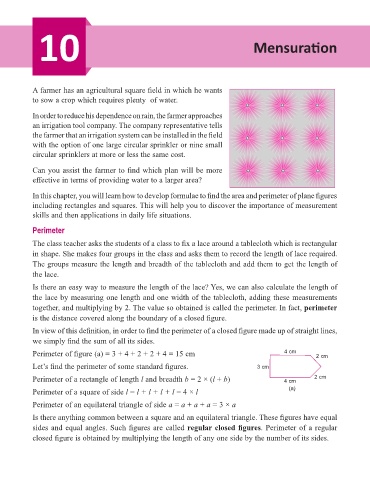Page 195 - Start Up Mathematics_6
P. 195
10 Mensuration
A farmer has an agricultural square field in which he wants
to sow a crop which requires plenty of water.
In order to reduce his dependence on rain, the farmer approaches
an irrigation tool company. The company representative tells
the farmer that an irrigation system can be installed in the field
with the option of one large circular sprinkler or nine small
circular sprinklers at more or less the same cost.
Can you assist the farmer to find which plan will be more
effective in terms of providing water to a larger area?
In this chapter, you will learn how to develop formulae to find the area and perimeter of plane figures
including rectangles and squares. This will help you to discover the importance of measurement
skills and then applications in daily life situations.
Perimeter
The class teacher asks the students of a class to fix a lace around a tablecloth which is rectangular
in shape. She makes four groups in the class and asks them to record the length of lace required.
The groups measure the length and breadth of the tablecloth and add them to get the length of
the lace.
Is there an easy way to measure the length of the lace? Yes, we can also calculate the length of
the lace by measuring one length and one width of the tablecloth, adding these measurements
together, and multiplying by 2. The value so obtained is called the perimeter. In fact, perimeter
is the distance covered along the boundary of a closed figure.
In view of this definition, in order to find the perimeter of a closed figure made up of straight lines,
we simply find the sum of all its sides.
Perimeter of figure (a) = 3 + 4 + 2 + 2 + 4 = 15 cm 4 cm 2 cm
Let’s find the perimeter of some standard figures. 3 cm
Perimeter of a rectangle of length l and breadth b = 2 × (l + b) 4 cm 2 cm
Perimeter of a square of side l = l + l + l + l = 4 × l (a)
Perimeter of an equilateral triangle of side a = a + a + a = 3 × a
Is there anything common between a square and an equilateral triangle. These figures have equal
sides and equal angles. Such figures are called regular closed figures. Perimeter of a regular
closed figure is obtained by multiplying the length of any one side by the number of its sides.

